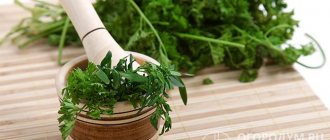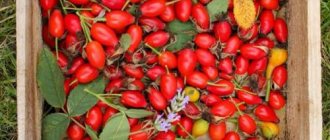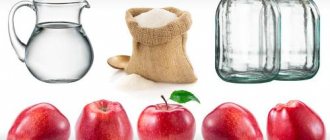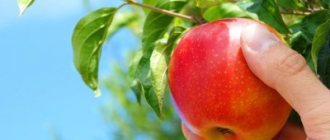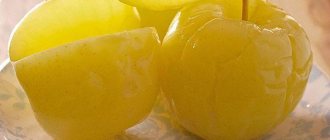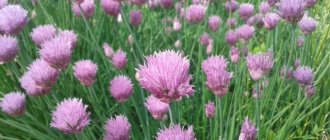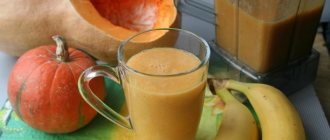Apple varieties for long-term storage
Summer and autumn apples will not last through the winter - this is an option for canning.
For long-term planting, choose winter varieties that ripen from late September to October and even early November. At 0 degrees, late apples retain their presentation and nutrients for up to 4-7 months.
The following varieties are suitable for storing at home:
- Vityaz - stored until the end of May - beginning of June.
- The Kuban apple is a high-yielding, disease-resistant variety with a shelf life until April - early May.
- Oryol winter - juiciness and taste are not lost even in March.
- Wellsie and Lobo - strong fruits diversify the diet in late February - early March.
- Antonovka vulgaris - the variety includes several varieties. Can be stored for up to 4 months.
Waiting for February on the balcony of a city apartment: Bolotovsky, Venyaminovsky, Kurnakovsky and Christmas apples. And Northern Sinap in the basement lasts until the second decade of June (the apple tree bears fruit in October-November).
Important. For long-term storage, winter apples are removed slightly unripe (technical ripeness). In this state, only the picked fruits do not have a pronounced taste. Richness and tart flavor appear over time. The longer winter varieties sit, the tastier they become.
Preparation
In order for the crop to be stored well all winter and even spring, you should:
- Harvest correctly.
- Sort it.
- Choose a storage location.
Before sending apples for storage, they should be sorted, sorted according to the following criteria:
- damaged and intact;
- mature and unripe;
- big and small.
Varieties
The length of storage of the crop directly depends on the variety of apples. Early and autumn fruits are not suitable for leaving into the winter. Only winter varieties need to be harvested.
Autumn varieties can also be stored, but not throughout the winter, but for a maximum of a couple of months, provided favorable conditions are provided, including a stable temperature of about 0ºC.
Popular winter varieties that have a long shelf life include:
- Semerenko;
- Antonovka;
- Golden et al.
Harvest time
Winter varieties should only be harvested when they are fully ripe. Harvesting too late or too early affects not only the appearance of the fruit, but also its taste.
In the middle zone, the first apple harvest is harvested in mid-August. But early varieties do not have a good shelf life .
Autumn varieties begin to be harvested at the border between August and September; they last longer, but not throughout the winter. Gradually they become soft and lose their taste. Winter varieties are intended for long-term storage; it is advisable to collect them from the end of September to mid-October.
You should not keep the fruits on the tree until frost , since frozen apples will not be stored all winter.
This article will tell you when to remove apples for storage.
Additional processing
Collected apples should not be rubbed, so as not to remove the natural coating on the fruit. If it is violated, the shelf life may be reduced.
Carry out additional processing:
- glycerin,
- a weak solution of potassium permanganate,
- in other ways.
You can find out how to process apples before storing them here.
Selection of containers
Most often, wooden boxes or cardboard boxes are chosen for storing apples. These methods are convenient, allowing you to compactly place the crop in the storage area. You should try to avoid contact of the fruits with each other.
For these purposes, one of the following methods is used:
- Wrap each apple separately in paper.
- Sprinkling with additional materials (shavings, sawdust, peat or sand).
- Unfolding through the gap.
Cardboard boxes, if they are chosen as containers, should first be taped at the joints or strengthened in another way so that they do not break under the weight of the apples.
Apple storage conditions
The varietal qualities initially inherent in nature and selection are fully manifested when optimal conditions are created.
Summer and autumn apples will not last through the winter
When laying for a long time, the following factors are taken into account:
| Conditions | Required mode |
| Storage | The best room is a basement, cellar, attic, storage room. In the apartment, apples are placed on balconies, loggias, in refrigerators, on window sills |
| Microclimate | Good air circulation, protection from light, compliance with temperature and humidity conditions |
| Selection of containers | The main rule is the strength and cleanliness of the box. Material, size, shape are also taken into account. If the container was used to store vegetables, it is washed with soap and soda solution |
| Laying | Large fruits are placed at the bottom, and smaller ones are placed on top. |
Important. Apples react negatively to proximity to root vegetables. If there are carrots, potatoes or onions nearby, these vegetables will quickly sprout, and the apples themselves will acquire a “cotton” structure and an unpleasant aftertaste.
Rejection of low-quality apples
A slight rotting of the apple may not be noticed, and if such a fruit ends up in storage, the process quickly switches to healthy fruits.
In order not to lose winter reserves as a result, after harvesting the apples need to rest for 2 weeks in a cool place. During this time, hidden defects will appear.
Only after this the crop is sorted for storage.
Fruits to be rejected:
- with stains, signs of rotting;
- with traces of pest activity;
- with mechanical damage;
- without stalks: an almost invisible hole opens the way for viruses, bacteria, fungal spores;
- small, irregular in shape.
There is no point in throwing away the scraps. After removing the damage, the fruits are dried, and in winter, aromatic compotes are prepared. The remaining fruits are sorted by variety, size and sent to storage.
Storage location: refrigerator, balcony, cellar, pantry, window sill
Refrigerators, balconies and window sills are more often used in city apartments, and basements and cellars - in private houses.
The choice of location is determined by the volume of apple supplies and the ability to create the necessary microclimate.
Storing apples in the refrigerator
The most affordable option for storing fruit at home is suitable for a small supply. Without additional processing, the fruits will last up to 2 months.
Without additional processing, the fruits will last up to 2 months.
For a longer period, it is necessary to remove ethylene from apples - a substance released by fruits during storage and accelerating ripening. To do this, it is enough to keep the batch in a warm room (+23…+28 °C) for 3 days.
Note to the owner. If the refrigerator is chosen as a place for apple supplies, you should not place fish or smoked meats here. The specific smell of these products will penetrate through the holes in the bag, and the apples will lose their fruity aroma.
Balcony and window sills
A balcony in a city apartment equipped for storage is equivalent to the basement of a private house.
Here, the winter stock, depending on the variety, will last up to 6 months, but first you need to create a suitable microclimate:
- Balcony glazing should protect against precipitation and create natural air circulation.
- The temperature should not fall below 0 °C, otherwise the apples will freeze. But even +6…+7 °C is already critical: the pulp acquires a “cotton” structure. The recommended mode is from 0 to +3 °C.
- You will have to give up heating the balcony. Radiators dry out the air a lot.
For balcony bookmarks, you can make racks with niches. Another option is cardboard, wooden boxes, lattice chests, and wicker baskets.
Window sills are not suitable for long-term storage, since heating devices are installed under the windows. For everyday use, you can place a small batch here, but the apples will last for 1-1.5 months.
Cellar or basement
Niches below ground level are optimal in terms of conditions. If the space allows, the entire harvest from the dacha plot is placed here, and it will last until the summer.
Niches below ground level are optimal in terms of conditions
In the summer heat, basements and cellars are opened and dried.
To protect against fungus and mold, disinfection will be required:
- the walls are whitewashed with lime mortar (2 kg of lime + 200 g of copper sulfate per 12-15 liters of water);
- the floors and ceiling of the basement are treated with copper sulfate (500 g per 10 liters of water);
- shelves and racks are washed with vitriol and covered with disinfectant lime;
- The bottom of the cellar is compacted and debris, remaining sand and earth are cleaned out.
Important. After treatment, the basement and cellar are dried for 2-4 weeks and only then winter supplies are placed in them, so preparation must be carried out at least a month before laying.
Pantry
At home, use only a cool pantry with equipped shelves. Apples are placed in plastic bags with holes or in boxes. You can make shelving with open niches.
At home, use only a cool pantry with equipped shelves
How long do apples last fresh?
In terms of ripening, earlier varieties do not have a very high shelf life, but later varieties last much longer - up to 7-8 months, since they have a longer ripening period. The duration of storage depends on many factors:
- preliminary preparation;
- timely harvesting of fruits;
- compliance with storage technology;
- on the quality of processing - if it was carried out.
Experienced gardeners believe that even the type of soil, the amount of fertilizer and climate significantly affect the duration of storage.
Average values:
- on the windowsill – 5-10 days;
- in the pantry - 2-3 weeks;
- in the refrigerator - up to 6-7 weeks;
- after cutting into slices – 3-5 days in the refrigerator or 8 months in the freezer;
- apple puree – 7–10 days in the refrigerator, up to 2 months in the freezer.
Apples bought in a store or market can be stored much longer. Often, before transportation, fruits are treated with special substances that prevent them from spoiling - artificial wax compounds. They create an additional protective layer, preventing microbes from penetrating under the skin.
Temperature and humidity
Even after being removed from the branch, vital activity continues in apples:
- the apple “breathes”, absorbing carbon dioxide and releasing oxygen;
- it needs moisture for cellular metabolism;
- fermentation and ripening of the fruit takes place.
All these processes are optimal at temperatures from 0 to +4 °C. However, the variety determines a lot. The same Northern Sinap or Antonov apples prefer coolness: they are stored in conditions from -1 to +3 °C. The recommended humidity for any winter variety is 85-92%.
A slight deviation from the norm does not mean immediate damage to the winter stock. It’s just that the shelf life will be shortened, the structure of the pulp will deteriorate, and the taste of the fruit will not fully manifest itself.
Premature spoilage
How to keep apples fresh for a long time? To prolong the freshness of the fruits after picking, you need to learn how to remove them from the tree correctly , strictly observing the recommended timing. Long-stored varieties are recommended to be harvested 1-2 weeks before full ripening. Autumn and winter varieties are most suitable for long-term storage
It is recommended to collect fruits in dry weather ; the stem should be preserved, so the apple will not wither longer.
a special layer on the surface of the fruit that prevents spoilage of the fruit, which is not recommended to be washed.
After harvesting, the fruits are cooled, the optimal temperature is 1-5ºC; a cellar, an insulated garage, a glazed loggia or a balcony are best suited for these purposes. Boxes or plastic bags can be used as containers.
Wrapping them in newspaper or wrapping paper .
The following factors can cause premature spoilage
- overdose of nitrogen or potassium fertilizers;
- calcium deficiency in apples;
- getting infected fruits into a container with healthy ones;
- prolonged rains;
- keep warm.
You will learn how to properly prepare apples for storage in this video:
Container and shelf life
The following containers have been tested in practice for long-term storage of apples at home:
- Shelving. They are made according to the height of the walls with drawers or hinged doors. It is easy to get supplies from such niches and control their safety. The fruits are freely arranged in one row. Apples will keep for up to 6 months.
- Wooden boxes. They have a solid bottom and slatted walls. The design promotes the circulation of moisture and air. If other conditions are met and after 4-6 months of storage, the fruits are juicy and rich in nutrients.
- Plastic boxes with lattice walls. Containers are selected with small cells, a thin layer of sawdust or sand is lined on the bottom, and a layer of natural material is laid so as to cover the sides of the box. The apples are laid out in layers, with the bottom row being slightly denser than the top. The stock is stored for 3-5 months.
- Thermal box You will need two cardboard or wooden boxes of different sizes, but the same shape. The bottom of the larger one is lined with insulation - shavings, polystyrene foam, paper, cotton fabric. A second box is installed on top, the voids between the walls are filled with insulation. The apples are stacked in layers, wrapping each fruit in paper. The filled container is covered with cardboard and cloth. Storage period – up to 5 months.
- Carton boxes. The container is hygroscopic, so the bottom must be lined with shavings and seed husks. Several holes are made on the side surface, and to increase strength, they are taped along the seams and the perimeter of the bottom. Shelf life – 2-4 months.
Advice. For large batches of apples of several varieties, a mark is made on each package/niche about the variety, number of fruits, and date of placement.
Preservation recipes for long-term storage
You can also preserve the harvest for a long time by canning. I have a couple of recipes that I really like. I make them every year. I will share them with you.
Compote with apples and lemon
I like to complement apple compotes with other fruits. Most often I add lemon. It gives a slight sourness and citrus aroma.
Ingredients:
- apples - 3 kg;
- lemon - 1 piece;
- sugar - 350 g;
- water - 1.5 l.
Cooking sequence:
- Wash the fruits in water. Cut each into 4 pieces and remove the core.
- Immediately place the pieces in acidified water (5 g of citric acid per 1 liter of water) to prevent them from darkening.
- Wash the lemon and cut into small cubes.
- Bring water and sugar to a boil. Boil the syrup for 2-3 minutes.
- Place apple and lemon slices in sterilized jars. Fill the container with syrup. Leave covered for 5 minutes.
- Drain off the liquid to re-boil. Repeat the filling procedure. Roll up the lid. After cooling, you can put it in a dark place for storage.
Shelf life - from a year or more. Calorie content per 100 g - 95 Kcal.
Exotics growing at home? Then read how to care for an indoor orange so that it brings a good harvest.
If you wish, you can add other fruits or berries to the compote.
Apple jam
I also like to make jam. You can use it as a filling in baked goods (for example, make charlotte), or simply drink tea with it.
Grocery list:
- apples - 650 g;
- granulated sugar - 400 g;
- water - 150 ml.
Do you make apple jam?
Not really
Step by step recipe:
- Rinse the fruits well. Remove the skin from each, cut into 4 pieces and remove the core.
- Chop the slices into smaller pieces. Place in a thick-bottomed saucepan. Add water and half the sugar there.
- Stir and bring the mixture to a boil. Boil over high heat for 30 minutes.
- Add the remaining amount of sugar to the fruit mixture. Reduce heat to low and simmer for an hour. Stir constantly.
- While the jam is cooking, prepare the jars (rinse them with soda solution and dry). Then spread the jam into them while hot.
- Roll up the lid. Cover with warm clothes and let cool.
Author's note
Natalia Papanova
Blog author
If the apples are not very juicy, add more water.
Shelf life is up to one and a half years. Calorie content per 100 g - 245 Kcal.
For another recipe for making apple jam, watch the following video:
Pickled apples for the winter
Pickled apples require more ingredients. But the result is worth it: the snack turns out excellent.
Grocery list:
- apples - 1.5 kg;
- water - 1 l;
- vinegar 9% - 1.5 tsp;
- lemon juice - 1 tsp;
- sugar - 1 glass;
- salt - 0.5 tsp;
- bay leaf - 2 pcs.;
- star anise - 2 pcs.;
- clove buds - 4 pcs.;
- cinnamon - 2 pods.
Step by step recipe:
- Wash the fruits. For small ones, simply remove the core, cut larger ones in half
- Place in acidified water to prevent darkening.
- Blanch (2-3 minutes). Then place the fruit in a colander to drain off excess liquid.
- For the marinade, boil water with salt and sugar, pour in vinegar in a thin stream. Boil for 5 minutes.
- Place herbs, spices and apples in sterilized jars. Pour in the marinade and cover with a lid.
After cooling, you can store it in a dark and cool place. Shelf life - one year. Calorie content per 100 g serving is 67 Kcal.
Use firm apples for pickling.
Apple jam with cinnamon
For those with a sweet tooth, I recommend making jam. You can add cinnamon for additional aroma and taste.
List of ingredients:
- apples - 1 kg;
- sugar - 2.5 tbsp;
- water - 100 ml;
- cinnamon - 2 sticks;
- ginger - 3 centimeters;
- rum (or cognac) - 1-2 tbsp. l.
Cooking sequence:
- Wash the fruits. Cut into small squares. place in a saucepan.
- Add sugar there. Cut the ginger into thin strips and add it along with cinnamon. Leave for 30 minutes.
- If the juice released is not enough, add water.
- Heat the mixture over low heat. Wait until the sugar dissolves. Then turn the heat to medium. Boil for 30-40 minutes.
- Five minutes before cooking, add vinegar and alcohol. Before putting the jam into jars, remove the cinnamon sticks. Roll up the lid.
Shelf life is from one and a half years. Calorie content per 100 g serving is 265 Kcal.
Do you make apple cinnamon jam?
Not really
Apple marshmallow
I think many have tried marshmallows. But not everyone decided to do it. Although in reality it is not that difficult. I will share my favorite and proven recipe.
Grocery list:
- apples - 1.2 kg;
- sugar - 60 g;
- water - 50 ml;
- vegetable oil - 1-2 tbsp.
Step by step recipe:
- Wash the fruits, remove the core, peel and cut into medium-sized pieces.
- Place in a saucepan and add water. Place on low heat and cook for 30 minutes. Then let cool and drain off excess liquid.
- Grind the pieces into a puree (you can rub through a sieve or use a blender).
- Add sugar to the mixture. Put it back on the fire and cook for 15 minutes.
- Cover a baking sheet with parchment paper and grease with vegetable oil. Spread the applesauce over the surface in a thin and even layer.
- Place the baking sheet in the oven, preheated to 130 degrees, for an hour and a half. Do not close the door completely.
- Remove and let the dessert cool. Cut along with the paper into longitudinal strips. Peel from parchment and roll.
Author's note
Natalia Papanova
Blog author
Even those apples that have fallen from the branch are suitable for making marshmallows.
Shelf life 2-3 months. Calorie content per 100 g serving is 285 Kcal.
Apple marshmallow turns out dark in color
Storing apples in the refrigerator
After harvest, your own harvest is placed in the refrigerator no later than 24 hours; store-bought crops are placed in the refrigerator immediately after purchase.
Bookmark rules:
- the batch is sorted by size;
- the fruits are packaged in plastic bags of 3-5 kg each;
- for air exchange, several holes are made around the perimeter of the package, and the free edge of the package is sealed with tape;
- packages are placed in compartments with temperatures up to +3 °C and humidity 80-90%.
The fruits do not need to be washed: a natural wax film protects them from rotting.
Freezing
If you have a spacious freezer, you can partially freeze a large batch:
- Open frozen whole. Fresh fruits are frozen for 40 minutes, transferred to plastic bags, the air is released with a needle and placed in the freezer for storage.
- Freezing in slices. Apples are cut into equal pieces, frozen and packaged using the above method.
- Freezing chopped apples. Grate the fruits on a fine grater, place on a flat plate, and place in the freezer for 10-15 minutes. Divide the mixture into bags and place for final freezing.
Dried collections are used in compotes, decoctions, fillings for pies and strudels. The products are stored for up to 1 year.
Secrets of experienced gardeners
Advice from experienced gardeners will help you better preserve your apple harvest. The main recommendations include the following:
- Collect apples as carefully as possible. They cannot be wiped, poured from container to container, and especially not washed, since such actions can damage the natural waxy coating on the fruit.
- Sorting before sending for storage must be carried out.
The paper that is used to wrap apples before storage must be intended specifically for contact with food and not have a specific odor that can be transferred to the fruit.
- If during storage the fruits are sprinkled with additional materials, it is necessary to ensure that they are always dry and cover the apples completely.
- Each unit of storage container (box, plastic bag, etc.) must contain fruit of the same variety.
- Wormy fruits are not suitable for winter storage.
- It is recommended to pick apples in good dry weather.
- It is recommended to harvest from the lower branches, gradually moving to the upper ones.
- Apples should be placed with their tails facing up.
- Bulk storage saves space, but often results in the loss of a significant portion of the crop. This is due to the close location of the fruits and their contact. Moreover, if one apple spoils, the neighboring ones begin to rot.
- Improper fertilizing, untimely spraying, harvesting too late and other gardener mistakes can lead to fruit damage. Such fruits should not go into storage.
Extending the shelf life of the crop can be achieved by treating with carbon dioxide, glycerin, paraffin or ultraviolet light.
Drying and storing dried apples
In dry sunny weather, drying in the open air is suitable.
For drying, varieties with sourness, for example, Antonovka, are more suitable. Preparation:
- apples are cut and cored
- It is better to peel store-bought fruits;
- The prepared fruits are cut into slices or into slices 1 cm thick.
In dry, sunny weather, drying outdoors is suitable. The slices are laid out on a tray in a thin layer or strung on cotton threads, covered with a thin layer of gauze and placed in a shaded place.
In hot weather, dried fruits are ready in 3-4 days. When using a dryer, it is enough to set the temperature according to the instructions. Dried fruits are stored in paper or fabric bags.
Possible storage problems and their solutions
There are several common problems when storing apples.
The fruits darken
When storing fruits in closed plastic containers, the fruits turn black. The reason is that air exchange is disrupted; plastic releases toxic substances that are not tolerated by apples.
What to do:
- Transfer the batch to a wooden box with slatted sides, removing the black fruit. The remaining apples should not touch.
- It is impossible to say for sure whether the process affected other fruits. To be on the safe side, this part of the stock should be covered with sawdust.
The peel wrinkles and the apples become soft.
This means that the microclimate in the storage area is disturbed. A humidifier will correct the situation; if the room is too warm, add additional air conditioning.
The apples are rotting
If apples are carefully selected for storage, the reasons are as follows:
- poor storage conditions (excess moisture combined with heat, dirty containers);
- poor preparation of the planting site, and as a result - damage by a putrefactive pathogen;
- agrotechnical violations during cultivation (for example, an excess of chemicals and mineral fertilizers, watering before harvesting).
Spoiled fruits must be removed and, if possible, the box must be replaced; if necessary, storage conditions must be adjusted. For prevention, the room is irradiated with a bactericidal lamp.
How to store apples
Of course, if there is a cellar or underground, then ideal conditions can be created for storing the crop. But if you do not have such an opportunity, then this can be done in an apartment, and even in the ground. Here are some common ways to store apples.
Putting apples in boxes
Laying the crop in one layer for storage in boxes
The easiest storage method is considered to be placing apples in containers. To do this, they are placed with the stalks up in layers, without spacers between the layers. Usually make 1 or 3 layers. It can be placed in both wooden and paper boxes. The main disadvantage of this type of storage is that if the apple spoils in the lower layers, it will be difficult to get it out. And if one thing rots, then the rot quickly begins to spread to all the others.
Sprinkle apples for storage
If you want to increase shelf life, it is recommended to sprinkle each layer of apples. For pouring use:
- dry sawdust;
- sand mixed with soot or ash;
- peelings from onions, buckwheat;
- peat and moss.
Before laying, a layer of filling 3-4 cm thick is poured onto the bottom of the box, and apples are placed on it so that they do not come into contact with each other. Then a new layer of filling is poured, which should completely cover the fruits.
Wrapping an apple in paper
When wrapping with paper, it is important not to damage the fruit.
This method is more labor-intensive, but your crop will be better protected and will last longer than with conventional installation. Soft paper, such as napkins, paper towels or toilet paper, works best for wrapping. It is not recommended to use newspapers for these purposes, because they have sharp edges and you can accidentally damage the skin.
Only dry apples are packaged, and you should try to wrap them completely, and the paper should fit tightly enough. The wrapped apples are placed in the container placed in place with the stems facing up.
We store apples in polyethylene
Packages must be previously unused
You can also store the harvest in simple plastic bags. Only new packages are suitable for this. It is recommended to place no more than 3 kg of harvest in each bag. The bags are placed in storage areas and kept untied for the first 2 days so that condensation does not form in them due to temperature differences. Then they can be tied and a few punctures made for ventilation. Apples can be stored in bags both in the cellar and in the apartment.
